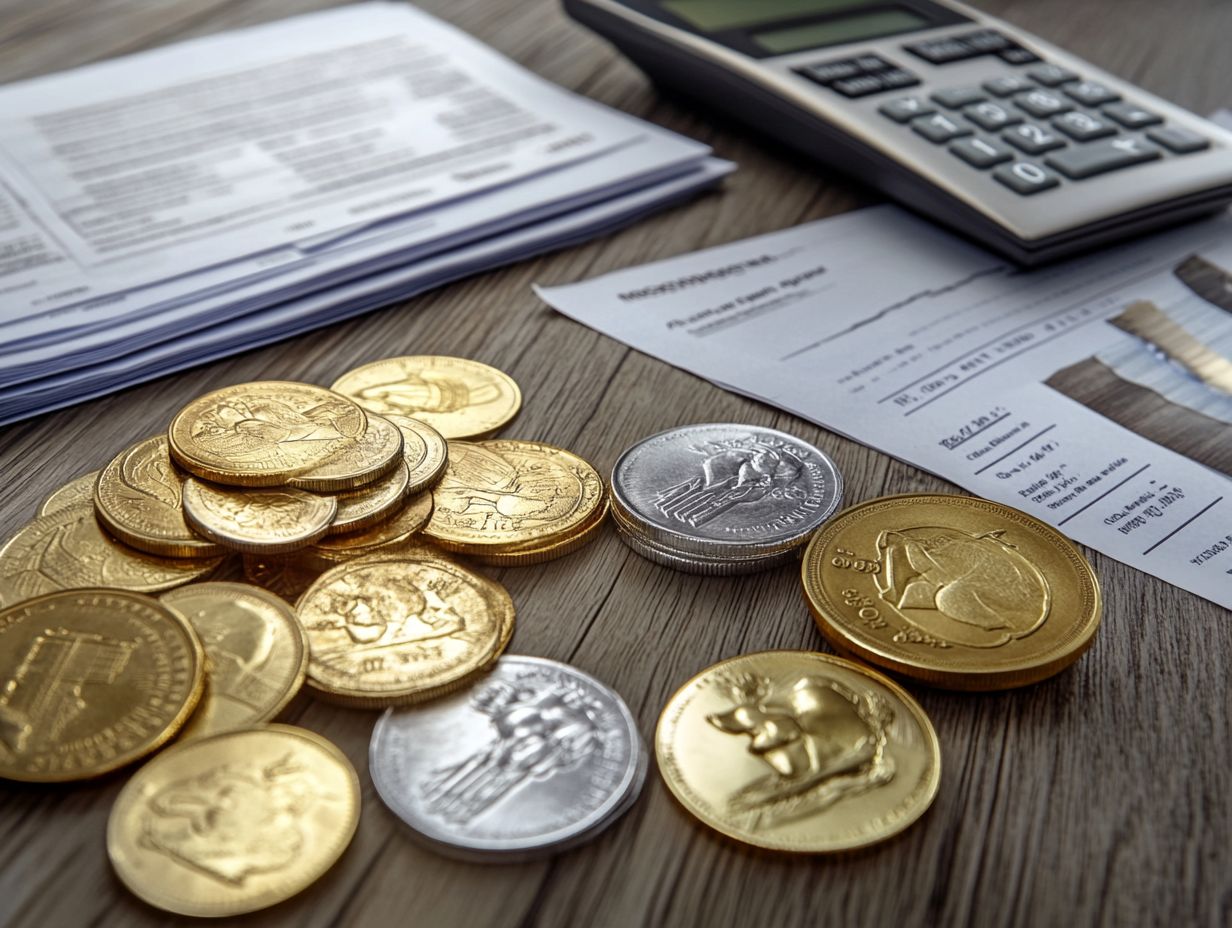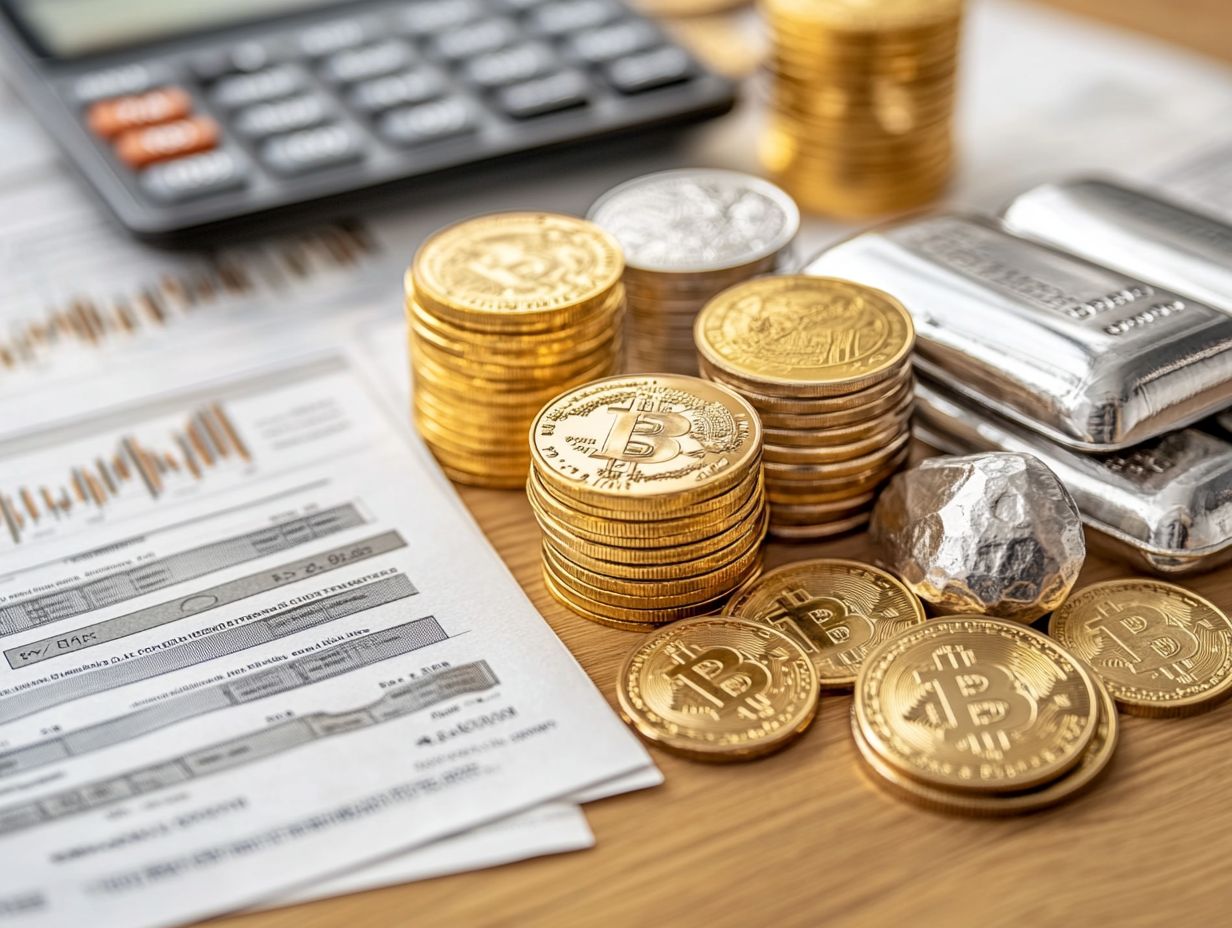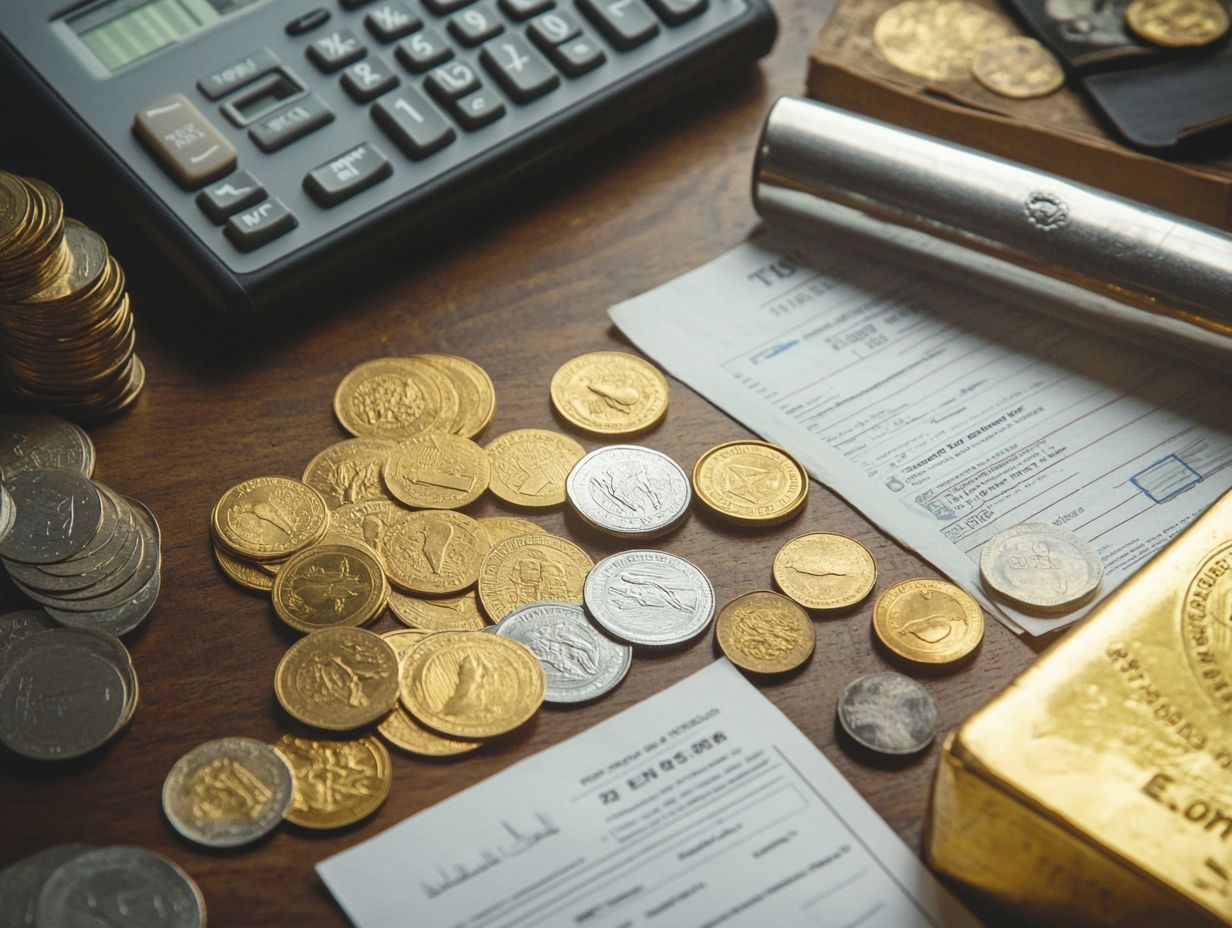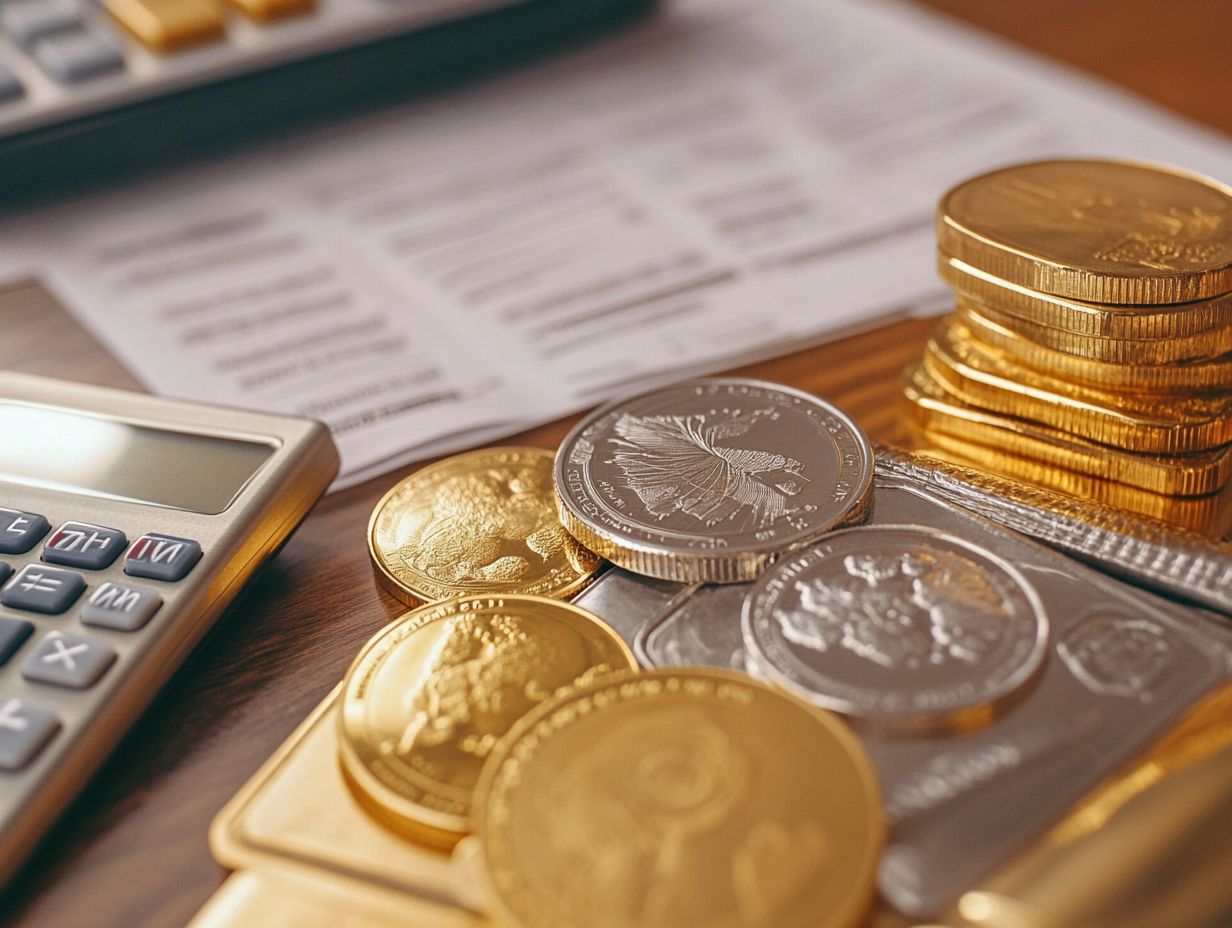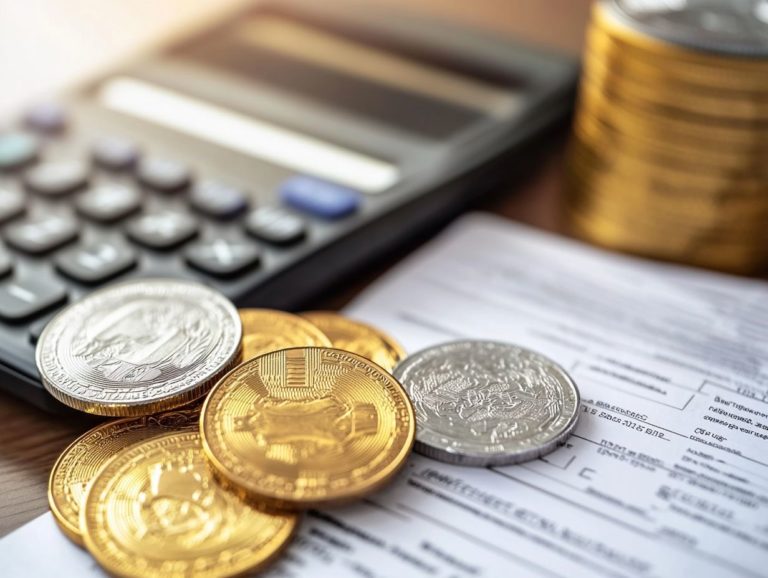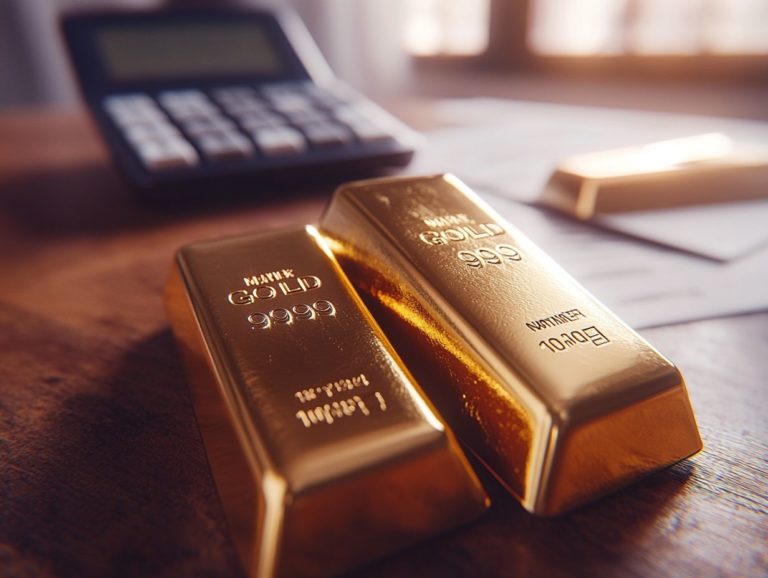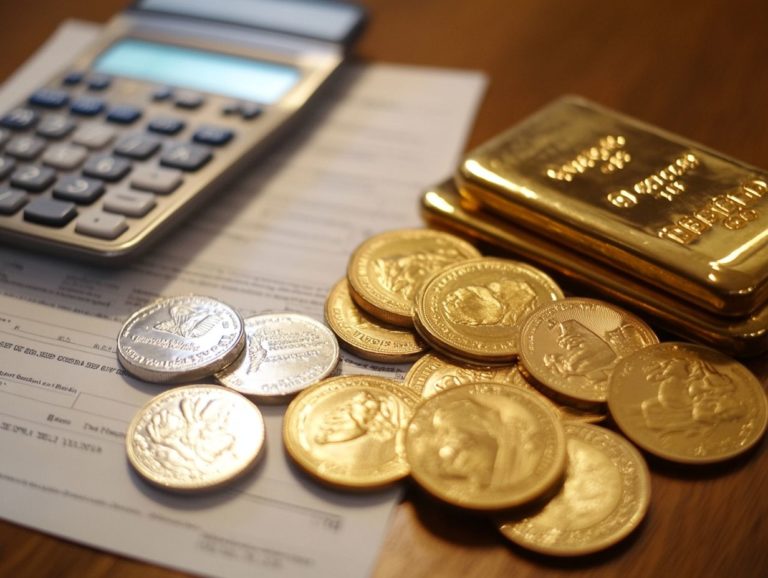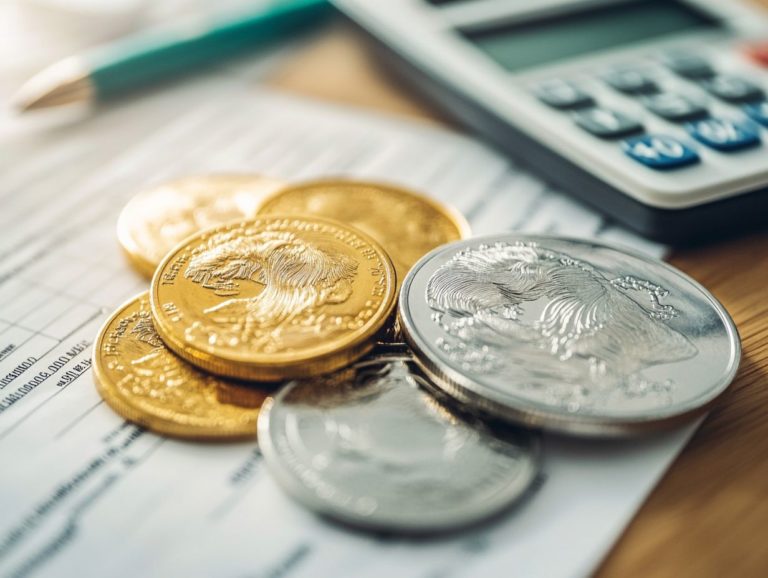Tax Implications of Holding Precious Metals as Assets
Investing in precious metals can truly be a rewarding venture, providing you with both tangible assets and a degree of financial security.
Understanding the landscape of these investments is crucial, from the different types of metals available to the associated benefits and risks.
This article delves into the tax implications tied to holding precious metals, covering everything from taxation on gains and losses to your reporting responsibilities.
You’ll also discover strategies for minimizing your tax burden, alongside important considerations such as storage, insurance, and the impact of economic conditions.
Whether you’re a seasoned investor or just beginning your journey, this guide will equip you with the essential knowledge to successfully navigate the world of precious metals.
Contents
- Key Takeaways:
- Types of Precious Metals
- Why Invest in Precious Metals?
- Tax Implications of Holding Precious Metals
- Strategies for Minimizing Taxes on Precious Metals
- Other Considerations for Precious Metals Investors
- Frequently Asked Questions
- What are the tax implications of holding precious metals as assets?
- Do I have to pay taxes on my precious metal investments?
- Are there any tax benefits to holding precious metals as assets?
- Do I have to report my precious metal investments on my taxes?
- How can I minimize the tax implications of holding precious metals?
- Are there any exemptions or special rules for taxes on precious metal investments?
Key Takeaways:
- Investing in precious metals can offer diversification and protection against inflation.
- Capital gains on precious metals are taxed as collectibles, while losses can be deducted against other capital gains.
- Tax-advantaged accounts and strategic timing of sales can help minimize taxes on precious metal investments.
Types of Precious Metals
Investing in precious metals has become a favored avenue for individuals seeking alternatives to conventional financial assets. Metals such as gold, silver, palladium, and platinum are not just cherished for their beauty; they also act as a safeguard against inflation and economic uncertainty.
While gold bullion remains the most recognized form, silver bullion is gaining traction for its industrial uses. Each of these precious metals possesses distinct characteristics and market behaviors, making them vital components of a well-rounded investment strategy.
Why Invest in Precious Metals?
Investing in precious metals gives you a solid asset that holds value. In times of changing global economy, you may find comfort in turning to precious metals like gold and silver to protect your wealth during inflationary periods and market volatility.
Their value in itself often appeals to those seeking diversification and long-term financial security. Incorporating precious metals into your investment portfolio can serve as a robust hedge against currency devaluation and geopolitical instability, enhancing your overall financial strategy.
Benefits and Risks
Investing in precious metals presents a unique blend of benefits and risks, making it crucial for you to evaluate your options thoughtfully. One of the standout advantages is the potential for high returns, especially with assets like gold and silver, which often appreciate during economic downturns. These metals not only diversify your portfolio but also serve as a reliable safeguard against market volatility.
However, it’s important to keep in mind the risks involved, such as fluctuating market prices, storage concerns, and the possibility of capital gains tax.
Precious metals can protect you from inflation, as their intrinsic value typically rises when fiat currencies weaken. If you’re looking to stabilize your investment strategy, incorporating precious metals can offer a counterbalance to traditional assets like stocks and bonds.
Yet, remaining vigilant about market trends and economic indicators that might influence these commodities’ prices is essential.
By understanding the nuances of precious metals, you enable yourself to make informed choices, harnessing the benefits while effectively mitigating any potential downsides.
Tax Implications of Holding Precious Metals
Understanding the tax implications of holding precious metals is essential for you as an investor, as it can greatly influence your overall investment profits. The IRS classifies precious metals as capital assets, meaning that any gains from their sale are subject to capital gains tax.
The rates you encounter can vary significantly based on the duration you held the asset—whether short-term or long-term. Specific rules apply to collectibles, which may incur a higher tax rate upon sale. This makes meticulous tax planning crucial for maximizing your investment returns.
With the right strategies, investing in precious metals can be a game-changer for your financial future. Start your journey today!
Taxation on Gains and Losses
Taxation on gains and losses from precious metals can be quite intricate. It primarily hinges on how long you’ve held your assets and the applicable tax rates.
When you hold an asset for more than one year, you benefit from long-term capital gains tax. This typically offers more favorable rates than short-term capital gains tax.
It’s essential to carefully keep track of your profits and losses to comply with tax regulations. Doing so can help you optimize your overall tax liabilities.
Grasping these nuances is vital for savvy investors like yourself. Short-term holdings—those owned for one year or less—can be hit with considerably higher tax rates, often aligning with ordinary income tax rates.
This can eat away at your potential profits. Therefore, it’s crucial to adopt strategies for efficient tax reporting.
One effective approach is tax-loss harvesting. This strategy allows you to offset taxable gains with losses, effectively reducing your overall tax burden. Staying informed about the specific reporting requirements for different forms of precious metals will further streamline your process.
This ensures that you meet your obligations while maximizing your investment returns.
Reporting Requirements
As an investor in precious metals, you must adhere to specific reporting requirements established by the IRS. This compliance helps you steer clear of penalties.
For instance, you’ll need to use Form 8621 to report certain transactions involving precious metals held in specific tax-advantaged accounts.
Keep accurate records! Understanding your obligations can save you money and is crucial for effective tax planning.
Tracking your purchases, sales, and distributions meticulously does more than satisfy IRS requirements; it also helps substantiate your claims during audits.
Moreover, this detailed reporting provides valuable insights into your investment performance. This enables you to make better financial decisions.
You should also familiarize yourself with other relevant forms, such as Form 1099-B. This form reports capital gains and losses, ensuring every aspect of your precious metals investments is documented thoroughly.
This proactive approach protects you from unexpected tax burdens and enhances your overall investment strategy.
Strategies for Minimizing Taxes on Precious Metals
Implementing effective strategies to minimize taxes on precious metals can substantially boost your overall returns as an investor. By utilizing tax-advantaged accounts like IRAs, you can enjoy the benefits of tax-deferred growth on your investment profits.
Working with a qualified financial advisor can help you navigate the complexities of tax laws. They can assist you in crafting tailored investment strategies that align seamlessly with your financial goals while optimizing your tax position.
Tax-Advantaged Accounts
Tax-advantaged accounts, such as IRAs, present you with unique opportunities to hold precious metals while reaping significant tax benefits.
Within your IRA, you can invest in physical gold, silver, palladium, and other eligible precious metals without facing immediate tax implications. This means your investment profits can grow tax-free until you decide to withdraw, which is a compelling advantage.
Understanding the IRS rules governing these accounts is essential for maximizing benefits and ensuring compliance.
Beyond traditional IRAs, you also have options like Roth IRAs and SEP IRAs. Each is tailored to different financial needs.
For example, a Roth IRA allows you to pay taxes upfront, enabling tax-free withdrawals in retirement—a particularly smart move if the value of your metals appreciates significantly.
Self-directed IRAs offer even greater flexibility, as they permit a broader range of precious metal investments. However, they come with strict regulations regarding storage and valuation.
By skillfully navigating these accounts and adhering to IRS rules, you can effectively build a diversified portfolio that capitalizes on the potential of precious metals.
Timing of Sales
The timing of your sales in the precious metals market is critical to securing capital gains—profits you make when you sell your investments for more than you paid for them—and achieving overall investment success. As an investor, you need to carefully consider market conditions, current trends, and your own investment strategies when deciding when to part with your holdings. Choosing the right moment can significantly minimize your tax liabilities and boost your profits. This makes it an essential element of effective tax planning.
Understanding the cyclical nature of prices and staying informed about global economic indicators will enable you to make timely decisions. For example, seasonal fluctuations in demand, geopolitical developments, and currency strength can all dramatically influence metal prices.
Being strategic about your sales timing not only impacts your profit margins but also helps optimize the tax treatment of your gains. By aligning your selling strategies with favorable market conditions, you can maximize returns while skillfully navigating the complexities of capital gains tax regulations. This ultimately ensures a more advantageous outcome for your investment portfolio.
Other Considerations for Precious Metals Investors
Investing in precious metals demands careful consideration of several factors that extend far beyond just buying and selling. You must think about storage, insurance, and the potential impacts of inflation and economic conditions.
Secure storage is vital for keeping your valuables safe from theft or damage. Insurance offers you that extra layer of protection. Understanding how inflation and economic trends affect the value of your precious metals is essential for making well-informed investment decisions.
Storage and Insurance
Proper storage and insurance for precious metals like physical gold and silver bullion are essential for your peace of mind. You have a range of storage options at your disposal, including home safes, bank safety deposit boxes, and professional vault services. Securing the right insurance can protect you against theft, loss, or damage, ensuring that your valuable investments remain secure.
Each of these options presents its own advantages and drawbacks. For instance, a home safe allows for immediate access, but it may not provide the security you could achieve with more specialized solutions.
Bank safety deposit boxes offer a secure environment for your assets, yet they restrict access to banking hours, which could be inconvenient when you need to access your investments. On the flip side, professional vault services deliver superior security and insurance coverage, easing your concerns about physical storage—though this often comes at a premium.
As you invest, remember to carefully assess insurance policies specifically designed for precious metals. Some plans cover theft-related losses, while others might exclude certain risks, allowing you to maintain confidence as you build your portfolio.
Impact of Inflation and Economic Conditions
The impact of inflation and economic conditions on precious metals is significant, directly influencing both their market value and your sentiment as an investor. During times of economic instability, precious metals often serve as safe havens, with their value typically rising as inflation erodes purchasing power. Understanding these dynamics is crucial if you’re looking to implement effective investment strategies and seize market trends.
Recent fluctuations in global economies, intensified by geopolitical tensions and shifts in central bank policies, have triggered market reactions that emphasize the importance of these commodities. As inflationary pressures increase, both individuals and institutions tend to gravitate toward gold, silver, and platinum as stable investments. This trend signals a quest for security and serves as a strategic move to hedge against uncertainty.
By tracking historical price patterns and assessing market sentiment, you can navigate the complexities of the precious metals market with greater confidence.
Frequently Asked Questions
What are the tax implications of holding precious metals as assets?
Holding precious metals can impact your taxes. Any profit or loss from selling metals may be taxed, usually as capital gains. Some metals, like gold and silver, might incur additional taxes.
Do I have to pay taxes on my precious metal investments?
Yes, you must pay taxes on any profits from selling your precious metal investments. This applies to both physical metals and funds. However, losses can be deducted from your taxable income.
Are there any tax benefits to holding precious metals as assets?
Yes, there can be tax benefits. Selling gold or silver coins might be taxed at a lower rate than other gains. These assets can also protect against inflation and offer benefits in some retirement accounts.
Do I have to report my precious metal investments on my taxes?
Yes, all precious metal investments must be reported on your taxes. This includes buying and selling metals and funds. Not reporting could lead to penalties from the IRS.
How can I minimize the tax implications of holding precious metals?
Consider holding precious metals in tax-advantaged accounts like IRAs. Long-term holding can also reduce capital gains taxes.
Are there any exemptions or special rules for taxes on precious metal investments?
Some states have exemptions for sales taxes on certain metals. Always check your state’s tax rules and consult a tax professional for personalized advice.




